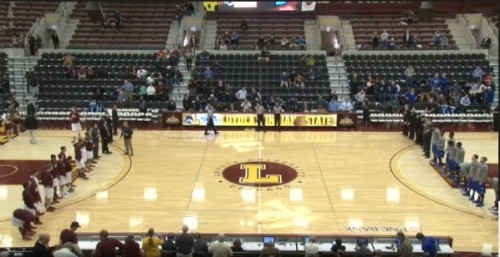Through the hype, emotions and many adjustments involved in Loyola moving to the Missouri Valley Conference, a key component of competitiveness has obviously been neglected. Home attendance has plummeted. Some of it can be chalked up to some nasty winter weather, and quite a lot to one of the least engaging home non-conference schedules in recent memory. But it’s an embarrassing way to make a debut into a new conference.
Through its first nine home games in the 2013-14 season, Loyola is averaging only 1531 fans per game. That’s down 34% from last year’s average of 2335, and less than half the next lowest team in the MVC. In a league where attendance, game day atmosphere, and energetic rivalries are not only a point of pride, but a real source of strength for recruiting, fiscal stability, and personnel retention, Loyola’s rotten attendance has become a running joke and source of ridicule throughout the conference.
Loyola has always had mediocre or below average attendance. It’s a constant struggle to command attention and get turnout in a large urban market with an abundance of professional and college sports, culture, nightlife, and other distractions. But it has never been this bad. Never.
Building attendance is all about creating a virtuous cycle. Establishing a critical mass of fans helps brings out more students, who raise the energy of the home crowd, which helps create a strong home court advantage, which improves winning, which brings better players, which brings more fans. If you leave out, skimp, or ignore any of the ingredients, the soufflé collapses.
This year’s non-con schedule is probably the worst I can remember. I’ve gone back through 35 years of home schedules, and while there were a few years with really lackluster competition, it was rarely ever worse than this year. There were no big names on the schedule at all, and there were none of the more prominent teams we’ve played at home recently in the non-con season– no DePaul, no Kansas State, no Mississippi State, no Purdue, no St. Louis– not even a Fordham or Western Michigan. Our entire home non-con schedule was composed of three former conference rivals (Milwaukee, UIC, Northern Illinois) and two schools you had to Google (Rockhurst and Campbell) just to make sure they were not fictitious.
The improvement of scheduling isn’t even just a matter of attendance; it’s the second tiebreaker to determine seeding for the MVC tournament after head-to-head record. So it’s possibly the difference between playing on Thursday or Friday at Arch Madness if the team is tied for sixth.
If the schools in the Chicago area want to improve attendance, recruiting, publicity, and the overall climate for college sports, they need to get over their petty, proprietary grievances and play each other– like they do in Philadelphia and other good urban college basketball markets. Besides building excitement and attendance, it’s also great for recruiting, and encourages top talent to stay in the city.
In the Philadelphia area, LaSalle’s top four scorers are from nearby; two of Villanova’s top five; two at Drexel; and two at Temple. By comparison, only one of Loyola’s top 6 scorers is from the Chicago area, and that player originally signed elsewhere. Only two of Northwestern’s entire 11-man roster is from the Chicago area. Even at UIC, a large public school in the heart of the city, only two of their top five scorers are from the Chicago area and both originally signed at schools hundreds of miles away.
Now that there are two fewer conference scheduling conflicts, Loyola (MVC), Northwestern (BigTen), DePaul (BigEast), UIC (Horizon), Chicago State (Western Athletic), Northern Illinois (MidAmerican), Valpo (Horizon), and Notre Dame (ACC) need to get together and create a rising college basketball tide that will lift all boats.
Closer to home, and more immediately, Loyola can’t expect to check off the box of improved conference competition and expect the long-neglected fandom and student population to wander into the Gentile Arena while a game happens to be going on. This means outreach at a personal level, by phone, by mail, and by paid advertising, augmented by relentless, personalized digital follow-up. Use of Constant Contact or other email services can personalize email and show the open rate, click through rate, and other important data. Some outreach efforts can be done in house, and others can be outsourced.
I’m pretty sure that if a focus group and large-scale survey were commissioned, it would show there’s a high correlation between whether other people in a peer group are attending, so specifically targeting opinion leaders in the alumni, student, and neighborhood resident groups would probably be effective. But maybe the focus group would show other things that can be done that amounts to lower-hanging fruit, like ticket price adjustments, parking considerations, or different seating configurations such as an additional student section under the opposite basket. We just don’t know, other than anecdotally, what the problem is.
In advertising and marketing, I think a video of students and prominent alumni giving testimonials about attending games would be effective. I’ve long thought an electronic message board should be installed on Sheridan Road at Kenmore or Winthrop to advertise athletics, academics, events, accomplishments, etc. I’m probably going to get smacked down for this, but if a small subscription fee was put in place for streaming video, I don’t think most fans would object. It could be included with season ticket packages. And the advertising, broadcasting and promotion budget needs to be looked at.
Creating a culture in which going to the games is “the thing to do” is a long-term prospect, and doesn’t necessarily have immediate return on investment. But it’s essential. Winning alone won’t do it, just as attendance alone doesn’t produce a winning team. It’s part of a holistic puzzle, a virtuous cycle that needs constant maintenance, and something that we’ve never really had in the athletic department. Let’s start now, so we’re one day closer to seeing it happen.
Visit the message board to comment.



